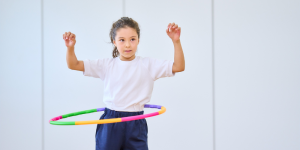Mastering Flexible Seating: How One Teacher Transformed Classroom Energy into Focused Learning
The Challenge of Managing Active Students
As Colleen Metzler took her first steps into her new 4th-grade classroom at Vergennes Union Elementary School in Vermont, she was immediately struck by the sheer energy of her students.
This group of youngsters was the largest class in the school, and it showed in their constant need to move. Metzler quickly realized that this high energy, while delightful, posed a significant challenge in maintaining classroom management.

Understanding the Initial Struggles
Balancing the students’ movement needs with effective learning wasn’t an easy task. Metzler wanted her students to feel comfortable and engaged, but without a plan, the classroom occasionally turned chaotic.
The students needed more than just occasional movement breaks—they craved continuous, dynamic ways to channel their energy.
Discovering the Solution: Flexible Seating
After much thought and observation, Metzler discovered an innovative approach: flexible seating.
She decided to introduce a variety of seating options that would serve as energy outlets and learning tools.
Benefits of Flexible Seating
With flexible seating, students could choose from various options like office chairs (or “rollie chairs”), exercise balls, wobble stools, wooden T stools, elastic kick bands attached to regular chair seats, and floor desks.
These choices allowed students to select seating that suited their need for movement and personal learning style, creating a more conducive learning environment.
Transitioning Through Trials
Initially, the flexible seating system wasn’t smooth sailing. Metzler faced the challenge of students misusing their new seating options, leading to frequent disruptions. It became evident that structure was crucial for success.
She experimented with different strategies to strike the right balance between freedom and control, eventually realizing that clear guidelines were paramount.
Moving Forward
Despite these early hurdles, Metzler’s commitment to flexible seating began transforming her classroom environment.
By focusing on structured implementation and setting clear expectations, she laid the foundation for a system that worked. This method not only catered to her students’ physical needs but also enhanced their ability to focus and learn effectively.
Thus began Metzler’s journey of transforming active classroom energy into focused learning. This chapter marks the turning point where she would begin to systematically refine and implement flexible seating, preparing her students for a more structured and engaging classroom environment.
The next step was developing a management system that would ensure the success of flexible seating by establishing clear expectations and rules.
Implementing Flexible Seating Options
Diverse Seating Choices
Colleen Metzler’s classroom is a dynamic and flexible environment, essential for catering to her lively group of 4th graders. Understanding the variety in student needs, she introduced a wide range of seating options:
- 🪑 Office Chairs (affectionately known as “rollie chairs”)
- 🏀 Exercise Balls
- 💺 Wobble Stools
- 🪵 Wooden T Stools
- 🦵 Elastic Kick Bands (attached to regular chair seats)
- 🖥️ Floor Desks (allowing students to work on their laps in groups)
These diverse choices give students the freedom to select the seating that best suits their learning style and movement needs.
Accommodating Various Learning Styles
Different seating options serve different purposes and can significantly enhance learning:
| 🪑 Seating Option | 📌 Description |
|---|---|
| 🪑 Office Chairs | Offer support and mobility, ideal for students who need to change positions frequently to stay focused. |
| 🏀 Exercise Balls | Allow for gentle bouncing and are great for students who need constant motion to concentrate. |
| 💺 Wobble Stools | Provide an outlet for fidgeting while maintaining focus on class work. |
| 🖥️ Floor Desks | Encourage group work and foster a more collaborative learning environment. |
These choices support Metzler’s goal to address the diverse movement requirements within her classroom, ensuring each student has the opportunity to thrive.
The Importance of Student Choice
Providing multiple seating alternatives empowers students by giving them control over their learning environment.
This autonomy can lead to enhanced engagement and a sense of responsibility. When students can choose their seating, they are more invested in their learning process, understanding that they have the power to shape their own productivity and comfort.
Metzler’s classroom transformation highlights the importance of addressing individual learning needs through innovative seating solutions.
As we delve further, we’ll see how clear guidelines and effective management help in maintaining a balanced and productive classroom atmosphere.
Learning from Early Mistakes
The Initial Challenges of Implementing Flexible Seating without Structure
As Colleen Metzler introduced flexible seating in her bustling 4th-grade classroom, she quickly discovered that the implementation process was far from smooth.
At first, Colleen simply provided various seating options, like office chairs, exercise balls, wobble stools, and floor desks, hoping they would cater to different student needs. However, without a structured plan in place, the classroom soon descended into chaos.
The flexibility in seating encouraged students to move around more freely, but this often resulted in uncontrolled movement. Exercise balls, designed to promote subtle, beneficial movement, turned into objects of play.
Wobble stools led to wiggling competitions, and students constantly shifted between seats, creating a distracting and disruptive environment.
How Uncontrolled Movement Led to Classroom Disruptions
The classroom, instead of becoming a haven for focused and energetic learning, became a hub of noise and distractions.
Students were rolling around, bouncing excessively, and generally undermining the purpose of having diverse seating options.
The playful atmosphere made it difficult for Colleen to manage her class effectively, and the lesson plans often got derailed.
The Realization that Clear Guidelines Were Necessary for Success
The initial chaos made it evident that simply introducing flexible seating was not enough. There had to be a system, a set of guidelines to regulate the use of these new tools. Colleen realized that to make flexible seating successful, she needed to instill a clear framework.
She began establishing rules concerning how the seating options could be used. For example, exercise balls were not to be bounced excessively, and students needed to remain stable on wobble stools.
Movement needed direction, and transitions between different seating choices had to be controlled. Colleen’s realization was pivotal in transforming the chaotic energy into focused learning.
As she moved forward with developing clearer guidelines, Colleen saw the importance of having structure to support flexibility.
The next step was to teach students appropriate behavior and movement limits, ensuring that the innovative seating arrangements contributed positively to their learning experience.
This marked a turning point in Colleen’s approach, setting the stage for creating an effective management system that would foster a balanced and engaging learning environment.
Developing an Effective Management System
Establishing Clear Expectations and Rules
Colleen Metzler quickly discovered that to make flexible seating work, her students needed clear expectations and rules. She implemented guidelines for the use of each type of seating. For example, students were taught to:
- 🪑 Use office chairs (or “rollie chairs”) without racing around the room.
- 🏀 Bounce on exercise balls within limits to prevent distractions.
- 💺 Balance on wobble stools without tipping over.
These rules became the cornerstone of an orderly, yet dynamic classroom.
Teaching Movement Limits and Appropriate Behavior
To ensure every student benefitted from flexible seating, Metzler integrated lessons on movement limits and appropriate behavior. She explained why there were rules:
- ⚠️ Safety – to prevent accidents like falls or collisions.
- 🤔 Consideration – to ensure all students could focus without being distracted by excessive movement.
- 🙏 Respect – to maintain a conducive learning environment for everyone.
Students participated in role-playing activities where they demonstrated correct and incorrect behaviors.
This hands-on approach ingrained the importance of the guidelines more effectively than just listing rules.
The Demonstration Approach
Metzler’s innovative way of reinforcing these expectations involved a bit of practical demonstration. At the start of the year, she allowed students to test the limits of their seating options:
- Excessive bouncing on the exercise balls
- Rolling haphazardly in the office chairs
- Wiggling uncontrollably on the wobble stools
Other students observed these actions from the front of the room, watching how they disrupted the class.
This experience provided immediate feedback, highlighting why the rules existed and how their actions affected others.
With these strategies, Colleen Metzler’s classroom started to transform. Her students understood the importance of self-regulation and learned to balance their need for movement with maintaining a productive learning environment.
As they adapted to these expectations, flexible seating became an integral part of their daily routine, enhancing both their energy and focus.
Through these carefully developed management practices, students were not just following rules; they were learning to respect their peers and take responsibility for their behavior.
This set the stage for the next phase of their journey, where they would evolve into a self-regulating community, fostering an even deeper sense of accountability and collaboration.
Creating a Self-Regulating Classroom Community
Flexible seating has the potential to create a dynamic, engaged learning environment, but for Colleen Metzler, the key to the system’s success lies in promoting self-regulation among her 4th graders.
Implementing flexible seating wasn’t just about the physical setups; it required a cultural shift where students learned to balance freedom with responsibility.
Teaching Self-Regulation
Central to this sustainable approach was teaching students to monitor their own behavior and movement. Metzler began by establishing clear, understandable guidelines and demonstrating the consequences of exceeding them.
Early in the school year, she allowed students to test the boundaries, such as excessive bouncing on exercise balls, while the rest observed the resultant chaos firsthand. This experiential learning led students to appreciate the importance of self-discipline.
Metzler’s method taught students to recognize when their movements were interrupting their focus or that of their peers, fostering a sense of ownership over their actions. They learned that an enjoyable classroom environment depended on everyone’s cooperation and awareness.
Encouraging Peer Accountability
Beyond self-regulation, peer accountability became a cornerstone of the classroom. Students were encouraged to support and remind each other to follow the agreed-upon rules.
This collaborative model meant that behavior management wasn’t solely the teacher’s responsibility; instead, it was a shared effort. Peer interventions were often more effective than direct teacher intervention, as students felt a stronger sense of commitment to their classmates.
Metzler noticed that students would gently remind a friend to stop bouncing excessively or offer an alternative seating option if someone appeared restless. These small acts of accountability not only maintained order but also built a community where everyone felt responsible for the collective well-being.
Transforming Classroom Culture
- Over time, these efforts transformed the classroom culture. Flexible seating ceased to be just an arrangement of different furniture and became the bedrock of a collaborative, self-regulated learning environment.
- Students understood that their comfort and movement needed to be balanced with productivity and respect for others’ learning.
- Flexible seating thus became more than a physical setup; it evolved into an educational philosophy that supported autonomy and mutual respect. This culture shift helped make Metzler’s classroom a model of how movement and structured freedom can harmonize to enrich the educational experience.
- As students gained proficiency in self-regulation and peer accountability, the classroom dynamic shifted positively. This transformation underscored the broader impacts of movement and comfort in learning environments, paving the way for enhanced engagement and interaction among students.
- Moving forward, understanding the broader implications of such initiatives can reveal even more benefits. These insights are crucial for educators looking to replicate such models to improve learning outcomes and student satisfaction.
The Broader Impact of Movement in Education
Connection Between Movement and Improved Student Behavior and Engagement
Colleen Metzler’s innovative use of flexible seating ushered in a new era of classroom management and student engagement.
By providing a variety of seating options like office chairs, exercise balls, and floor desks, she discovered that movement could be a boon rather than a burden.
The connection between physical activity and enhanced classroom behavior was almost immediate. Students were less fidgety and more focused during lessons, leading to fewer disruptions and more productive class time.
This nurturing of an active classroom environment plays a pivotal role in cultivating better behavior and more engaged learners.
How Flexible Seating Contributes to Both Physical and Mental Health
Flexible seating doesn’t just improve behavior—it provides substantial benefits to both physical and mental health.
Traditionally, schools have required students to remain seated in rigid, uncomfortable chairs for long periods.
This setup can contribute to various physical ailments like poor posture and repetitive strain injuries.
In contrast, offering seating options such as exercise balls and wobble stools helps students maintain better posture and engage in minor physical activity throughout the day. This is crucial in avoiding physical ailments associated with prolonged sitting.
Additionally, this environment addresses various mental health aspects. Movement has been linked to the release of endorphins, which elevate mood and reduce feelings of anxiety and stress.
Students in Colleen’s class are given the freedom to choose how they sit, making them feel more in control and reducing anxiety related to rigid classroom structures.
This holistic approach addresses both physical and mental well-being, creating a more balanced and healthy learning environment for students.
The Role of Movement in Creating More Productive Learning Environments
- Flexible seating and movement transform classrooms into dynamic and productive learning spaces.
- This transformation is underpinned by the idea that when students can move around and change their seating, they are more engaged and less likely to become bored or restless.
- Incorporating movement into lessons, as seen at Vergennes Union Elementary School, ensures that students are physically active, which translates into increased concentration and better academic outcomes.
- Robyn Newton, the physical education teacher, highlights that integrating movement into the school day—including activities like dancing, stretching, and using the school forest—creates an energetic and engaged atmosphere.
- This incorporation goes beyond mere exercise; it enhances student learning by making lessons interactive and kinesthetic.
- In conclusion, the broader impact of movement in education is profound. The implementation of flexible seating has demonstrated significant benefits for student behavior, physical health, and mental well-being.
- The innovative use of movement within the classroom has cultivated a productive and engaging learning environment, showcasing the transformative power of breaking away from traditional rigid seating arrangements.
- Transitioning from understanding the general benefits of movement, the discussion will focus on the comprehensive strategies and real-life classroom examples that make these benefits tangible and sustainable.







